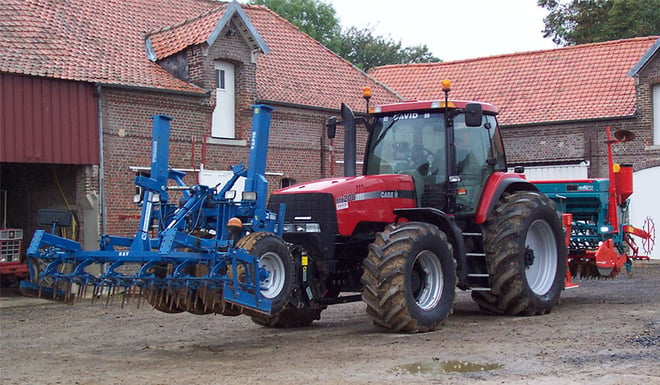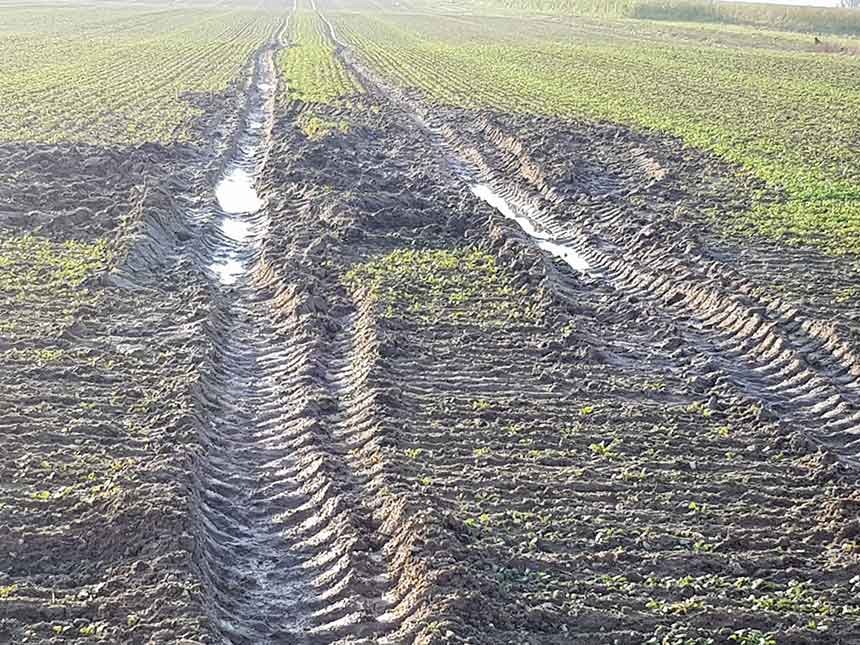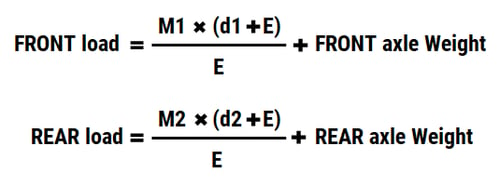It’s true that it’s quicker to opt for average inflation pressure, irrespective of the load linked to your implements or trailers. However, how can you be sure that you won’t overload your tractor tyres with implements that are too heavy, running the risk of the tyres wearing more rapidly, or worse still, causing damages which could result in the tyres having to be replaced?
Careful load management allows you to harness your tractor’s full potential; maybe you have the possibility of adding more load or working with heavier implements, or perhaps you should reduce inflation pressure to optimise traction and avoid slip, which will cause a lot of time loss.
In this article we explain how to define the total trailer load, choose the best load distribution and why to adapt inflation based on the weight of your implements.
Before looking in detail at the impact of overloading tractor tyres, we first need to consider the more general context, in which highway regulations or safety are just as important in terms of load.
The extent of the load carried by your trailer certainly has a direct impact on your tyres, but it can also lead to risks with respect to regulations, which generally limit the total weight of the load authorised on the road.
It’s your tractor’s engine power and the number of rolling axles which determine the maximum load capacity authorised by the highway code.
If you are pulled over, excess weight on the axle could lead to a fine or result in your trailer being immobilised in the event of an excessive overload.
The risk of overloading in terms of road safety can have an even greater impact if your braking system is not adapted to the weight of the load carried by your trailer.
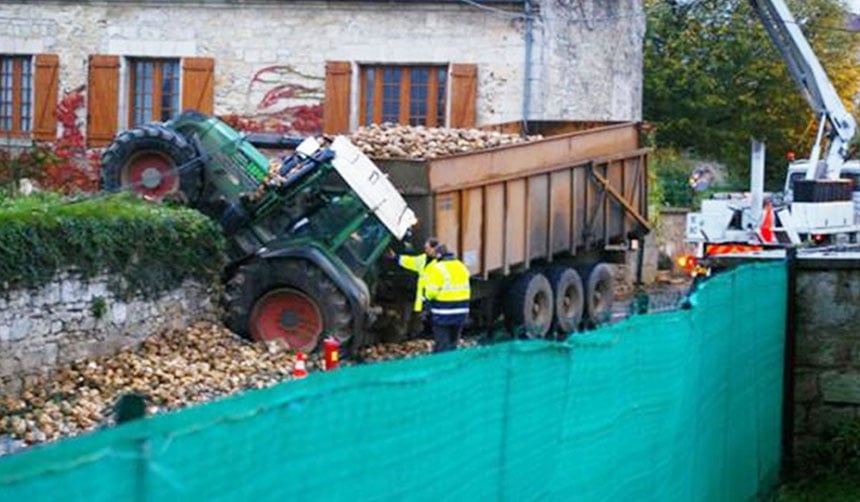 Braking accident linked to trailer overload
Braking accident linked to trailer overload
1. The pros and cons of efficient load management
What is the impact of load on traction?
To compensate for the weight of your implements or of your tractor/trailer combination vehicle, you must increase tyre inflation.
The heavier your implements, the more your tyres will be flattened under the effect of the weight. It’s the increase in inflation pressure that allows the tyres to bear the load and maintain their rolling capacity.
The disadvantage of high inflation pressure in the fields is that the tyre will sink deeper into the ground rather than flattening out on the soil surface. Its footprint is reduced, and the lugs have a smaller contact patch to grip the earth. More earth accumulates in front of the tyre when it sinks deeper, which increases rolling resistance.
How to avoid compaction despite the load
Right from the first passage, the overall mass of your tractor together with its implements exerts a force on the ground which can cause considerable compaction.
Over a long period and after many vehicle passages, this compaction will slow down root development in your crops and lead to loss of yields during the following seasons.
You can avoid compaction by reducing the global weight of your implements, or if this is not possible, by reducing inflation pressure with VF technology tyres which spread the weight over a larger contact area with the ground, or by opting for larger tyres which can carry more load without having to increase inflation pressure.
Why bad load management leads to premature tyre wear
Excessive load requires overinflation of the tyres which lose their suppleness with the increase in inflation pressure. The self-cleaning capacity is reduced, and earth accumulates between the lugs, which leads to an increase in slippage.
As a result, your trailer loses power, the wheels rotate faster than the tractor actually moves forward and wear increases in proportion to the increase in slip ratio.
2. How to define your total load
Do you know the maximum load for each tyre?
Each tyre has a load index written on its sidewall, which indicates the maximum load capacity for your tyre for a maximum speed (in general, with a nominal reference inflation of 1.6 bar).
This index is made up of a number followed by a letter, the number being the load index and the letter the maximum speed rating.
In the photo below 171 A8 is written on the left and 173 D on the right. 171 A8 corresponds to a maximum load of 6,150 kg at 40 Km/h and 173 D corresponds to a load of 6,500 kg at 65 Km/h.
To know your maximum load index, refer to the load index correlation tables supplied by our tyre manufacturer.
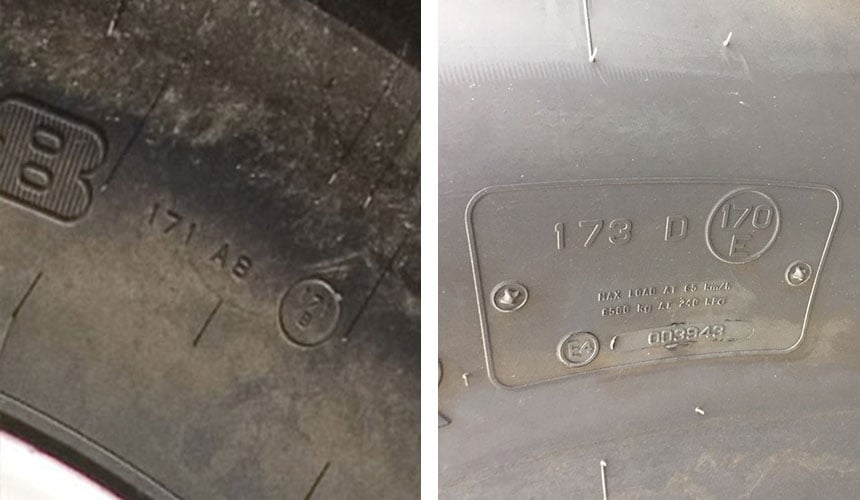 Load index indicated on the tyre sidewall
Load index indicated on the tyre sidewall
How to manage weighing with a suitable weighing tool
Here is how to define the load on each tyre if you have the right weighing tools:
- Weighing should be carried out per axle, starting with the front axle, by placing the rear implement in working position to avoid it acting as a counterbalance.
- Then you can weigh the rear axle, this time with the implement raised to establish the weight borne by your rear tyres during road transport.
- Then you can add ballast to the front of your tractor to ensure the right load distribution.
- Then check that the weight per tyre corresponds to the load index indicated on each tyre.
- You can then adapt inflation based on weight and speed.
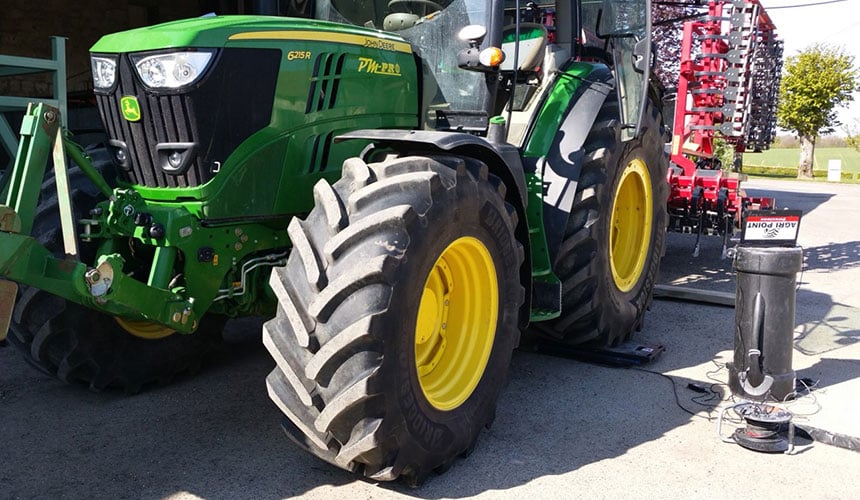 Use of weighing equipment
Use of weighing equipment
How to calculate load without weighing equipment
It is perfectly possible to calculate the load on the axle without having weighing equipment, just by taking a few measurements.
To make the calculation, you must have a minimum amount of information on the weight of the tractor, of your implements and ballast, which you can find in the manufacturer’s user manual:
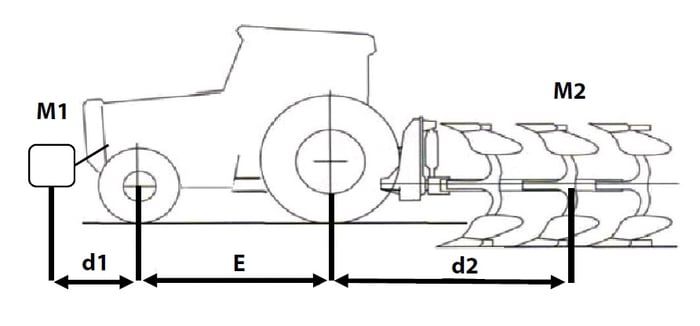
- M1: The weight of front ballast or the front implement.
- M2: The weight of the rear mounted implement.
- d1: Distance between the middle of the front ballast and the centre of the front axle.
- E: Distance between the middle of the front axle and the middle of the rear axle.
- d2: Distance between the middle of the rear axle and the middle of the rear mounted implement.
- Weight of the front axle: User manual.
- Weight of the rear axle: User manual.
When you have found all the weight related information in the user manual and you have taken the necessary measurements, you can make the following calculation:
As for the calculation using weighing equipment, you must check that the weight obtained corresponds with the load index indicated on each tyre.
You can then adapt inflation based on the intended load and speed.
What is the right load distribution?
If the rear axle bears most of the load transfer linked to the weight of the implement, your entire hitch is unbalanced. The front axle will have a tendency to lift up, leading to handling difficulties, with less responsive steering, above all in wet conditions.
In addition, the excess load on the rear axle is likely to lead to rear wheel slip.
The right load split for a four-wheel drive tractor is 60 to 65% of the weight on the rear axle and 25 to 40% on the front axle.
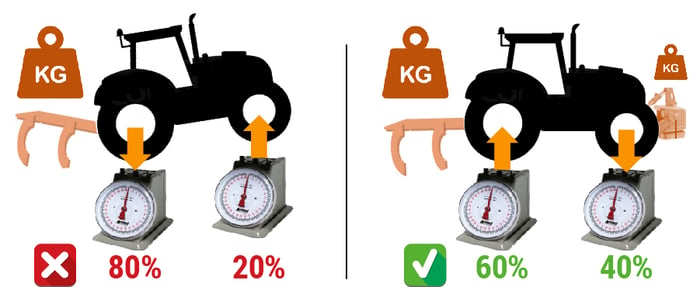 Rebalancing the load using front ballast
Rebalancing the load using front ballast
This split can be obtained by adding metal weights or a front implement and allows you to harness the power of the 4 wheels together, improving your overall traction capacity.
The load distribution over the axles is also linked to the tractor’s nominal power. The ratio is 50 kg per hp. To summarise, if you work with a 170 hp tractor, the tractor mass spread over the front and rear axle will be 8,500 kg, irrespective of the weight of the implements and ballasting.
3. With low-pressure VF technology tyres you can carry more load
VF (Very high Flexion) tyres are produced on a different technological basis than standard tyres. Their internal structure allows them to flatten out more without causing damage. They are more resistant to flexion, which means that they can carry 40% more load compared to a standard tyre.
They are therefore a good fit for work with wide, heavy implements. Using these tyres reduces the number of passages across the land, or the number of trips back and forth for transport by road during the harvest, for example.
With this type of tyre, in a large size, you will considerably increase your contact patch with the ground, allowing you to work with heavy implements without having to increase inflation pressure or add large amounts of additional weights. These tyres can work at an inflation pressure of between 0.6 bar and 0.8 bar, helping you improve your traction capacity while preserving your soil from compaction.
The Bridgestone-agriculture.eu blog is written and administered by tractor tyre experts who are available to provide you with the advice you need on the subject of your agricultural tyres. They allow you to maximise your productivity with information on all subjects linked to tyres: Cheap tractor tyres — Technical data for agricultural tyres — Air pressure advice — Solutions to avoid soil compaction — Sprayer tyre pressure — Why and how to ballast your tractor tyres — When to use dual wheels — The mechanical causes of abnormal wear — Cheap agricultural tyres – etc.
To learn more and boost your farm's profits, Bridgestone-Agriculture is offering you a free, detailed white paper that explains the essential role your agricultural tyres play in your productivity.
Most people who read this article have also read some of the following articles:
- 5 essential techniques to optimise your agricultural tyres
- Why your tyres’ speed index is primordial
- Increase the volume of your tyres to boost your tractor
- Why is the rolling resistance of tractor tyres a problem?
- Are my agricultural tyres suitable for use on the road?
- Which agricultural tyres are most suitable for working on sloping land
- How to maximise traction with my tractor tyres
- Agricultural contracting companies: improve team awareness about tyres
- Equipment sharing cooperatives: How to manage the agricultural tyre budget?
- Duals or low-pressure agricultural tyres: which to choose?
This information is intended only to make you aware of the technical and functional aspects of agricultural tires and their use. It does not allow you to make a judgment or a definitive conclusion on a given problem. Only your agricultural tire expert is able to make a technical assessment and take a final decision, case by case.
Leave a
commentary
Your email address will not be published.
Required fields are indicated with *


